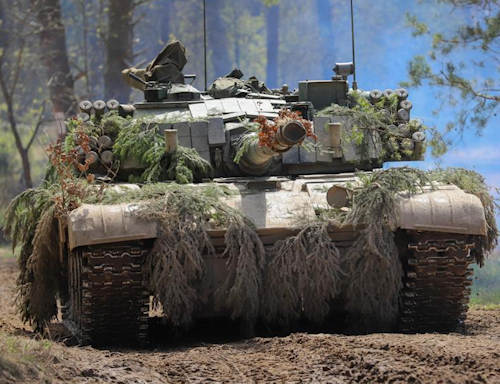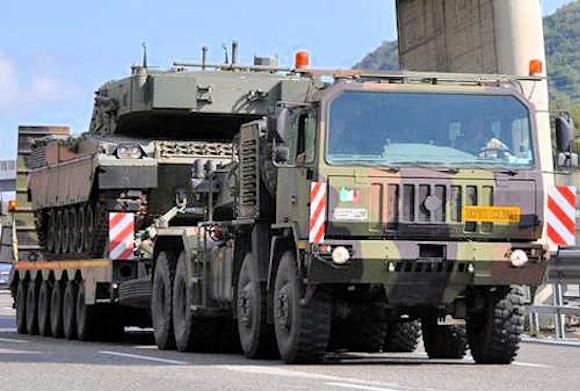I take my cue from the recent article by Major General Cutropia, entitled "Reflections on the "tactical formula" (armored vs armored vehicles)"1, published on August 19, 2022, to provide a thoughtful contribution in this regard.
I was able to observe that the author, in his article, made a reference to the traditional "shield vs spear" comparison and to the more recent "tactical formula", when he writes: “The combat vehicles are conceived by seeking possibly a perfect balance of the parameters of the so-called“ tactical formula ”. In several places in the writing, he also referred to "Logistic sustainability". And I couldn't take that for granted, quite the contrary.
In fact, he writes on several occasions that:
- “the issue of logistical support is always open”;
- “armored units have always associated a tracked combat vehicle with the tank… to facilitate“ logistic activities ”;
- "Armored and armored troops (heavy components of maneuvering units) must have adequate logistical assets".
There seems to be very little left to say, given the breadth of what has been said about these weapon systems. Instead, there is some further space for investigation on this topic, which I intend to exploit to identify some examples of connection or correlation with "logistical sustainability".
"Logistic sustainability" which is normally addressed after the application of the "tactical formula" itself, as part of the examination conducted with the "Doctrine, Organizations, Training, Materiel, Leader Development and Education, Personnel, Facilities, and Policy (DOTMLPF-P)".
Space of investigation that we now face by dealing with "logistic sustainability", through the parameters of the "tactical formula".
"Firepower"
 The "firepower" of a combat vehicle, of a tank in particular, is a parameter that, beyond appearances, has some peculiar implications of "logistical sustainability".
The "firepower" of a combat vehicle, of a tank in particular, is a parameter that, beyond appearances, has some peculiar implications of "logistical sustainability".
The storage limits of ammunition (temperature, humidity, pressure, etc.) and the frequency of their maintenance or chemical visits in the deposits as well as, in part, the capacity of "stowage" of the same in the "ammunition reserve" or "Santa Barbara ”aboard the combat vehicle are among them.
The rate of wear of the gun also has logistical implications, as it affects not only the frequency of maintenance (apart from that before and after the shot) but also how many to keep in stock for replacements, for example.
And the methods of refueling the shots to the vehicles themselves, the checks to be carried out, the frequency of maintenance on the "artillery" component (firearm, optoelectronics, computer programs, etc.) in the "turret" part have implications of "logistical sustainability" ”Of the combat vehicle (in analogy to those“ transmissions ”or“ motorization ”) and the choice of the level of specialization of the most complex maintenance interventions.
These interventions must be "scaled" in ascending order of specialization at the various ordering levels of the units (crew, company / squadron, battalion / squadron group, regiment, brigade) to reach the logistic support bodies or industry.
I will return to the maintenance aspect in the rest of this article, regarding the second parameter "protection" and the third parameter "mobility".
"Protection"
Even the second parameter of the "tactical formula", that of "protection", has intrinsic connections to "logistical sustainability". In some ways interesting connections.
The increase in engine power, to compensate for the increase in the weight of the vehicle, consequently increases its fuel / lubricant consumption, bringing the frequency of top-ups closer together.
This could also lead to the need for further adjustments, where necessary: increase in the vehicle's tanks (with another weight increase mainly due to fuel, to be compensated for) or the addition of a driver and a tanker to the staff. of the unit.
 The negative effects of the "explosion" of reactive protections ("tiles"), the fragments of which could hit the foot soldiers accompanying the tank, can be mitigated or eliminated, as described in the article. But, in the event that a combat vehicle is hit and the protections (of any type) come into operation by exploding or changing in shape, thus attenuating the effects of the blow received, there remains the question of when and how to repair or replace them.
The negative effects of the "explosion" of reactive protections ("tiles"), the fragments of which could hit the foot soldiers accompanying the tank, can be mitigated or eliminated, as described in the article. But, in the event that a combat vehicle is hit and the protections (of any type) come into operation by exploding or changing in shape, thus attenuating the effects of the blow received, there remains the question of when and how to repair or replace them.
In short, it will be necessary to decide when and with what times and methods these protections must be restored to put the combat vehicle back in a state of efficiency. And this implies a maintenance intervention, sooner or later, to be carried out at the various order levels of the aforementioned switching units. Unless you want to abandon the hit wagon or leave it in the hands of the enemy.
Also afterwards "The inclusion in the platform of detection and interdiction systems for the anti-tank and air threat", increasingly necessary to cope with the rapid spread of increasingly advanced anti-tank ammunition, a careful study of the maintenance of these systems will be needed, choosing at what level to do it, at what frequency and in what time. "Detection and interdiction systems" which, moreover, "chasing" the threat, could be added in increasingly sophisticated and energy-intensive forms to those existing for shooting and movement. This, as users, absorbing more and more energy from the powertrain, with all that goes with it. Especially in the case of tanks, which represent the highest paying targets for the enemy.
"Mobility"
The assemblies and sub-assemblies (or assemblies / sub-assemblies) of the "engine" component, similarly to those of the "artillery" or "transmissions" component2, must also be studied in relation to the type of maintenance interventions to be carried out at the various ordering levels of the units and then of the support or industry.
Here I mean the repair / replacement, by way of example, of rubber "shoes", tracks, powertrain or fuel safety tanks, to get to activities that require much more specialization. Activities, the latter, which may concern major maintenance, general overhauls (essential to completely restore the reliability of the weapon system) or modernizations.
Still on the subject of "mobility", the measures useful to "preserve" the efficiency of the crews should be studied. I am referring, for example, to the means of transport of the tanks themselves to get them as far forward as possible, considering the tactical situation, thus avoiding to "tire" the personnel and "wear out" the vehicles themselves in costly transfers.

Not to mention the recoveries and evictions of the material, including the same inefficient tracked vehicles on the battlefield, with suitable means, to be developed or acquired.
The risks associated with the decreasing trend in the number of military crews should also be weighed. This trend could lead to preventing or limiting any "rotations" of members in on-board assignments, or for carrying out maintenance. Maintenance activities (including repairs) that are essential to keep the tank in a state of full efficiency, for example, during periods of stasis on the battlefield. As well as, of course, in peacetime, before and after training or carrying out fire exercises in the shooting ranges or use in operations.
There would be many other things that could be highlighted, from the point of view of "logistical sustainability" but, for the purposes of this brief examination, I believe that what has been mentioned may suffice.
Conclusion
With regard to the foregoing, I must first fully agree with the colleague and writer of the article, from which I took inspiration, when he states that the evolution of combat vehicles must take place upstream according to the traditional "shield vs spear" comparison and that the needs, in logistical terms, are manifold.
Secondly, with the examples given on the subject of "logistical sustainability", I believe that I have at least given a glimpse of some of the many logistical issues that can / should be addressed, downstream of the “tactical formula”, during the examination conducted using the aforementioned DOTMLPF-P approach.
Thirdly, I hope to be able to communicate that the same different logistical problems concern not only the maintenance of the combat vehicles in a state of efficiency (maintenance, supplies, recovery and evictions) but also the preservation of the military operations of the crews that employ such weapon systems on the ground.
Basically, after the harmonization of the "tactical formula" of combat vehicles, the problem of their "logistic sustainability" always arises.
In other words, the "logistic sustainability" represents the "necessity" of the "tactical formula" for the improvement of the combat vehicle!
Salvatore Loria
The Major General of the Italian Army Salvatore Loria comes from the courses of the Military Academy of Modena and the Application School and attended the War School and the Senior Staff Course.
He commanded the units at the platoon, company, battalion level (framed in the Brigade) and then regiment. As a general, he also headed the Joint Logistics Training Center and the South Defense Heavy Maintenance Pole. In addition, he has carried out various positions of staff at the operational units or central bodies in Italy, including those relating to combat or engineering vehicles, and at the command of the mobile rapid intervention force in Germany in the field of doctrinal and standardization. .
He participated as unit commander in operations in Kosovo and Lebanon and was part of the staff of national or multinational commands in Mozambique and Bosnia.
He is awarded the title of Officer of the Order of Merit of the Italian Republic.
1 In the article, the abbreviation "vs" stands for the Latin word "versus". It indicates, following the example of English, the contrast between two entities. Specifically between armored and armored vehicles.
2 To which to add the materials of "commissariat" (clothing of the crews / combat rations) or "health" (boxes / medication packages).
Photo: US DoD / US Army / Italian Army












